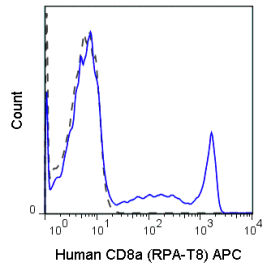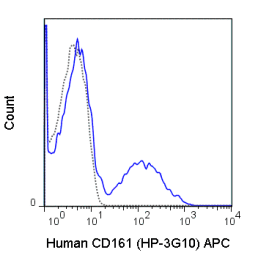| Cat No. | Size | Price |
|---|---|---|
| 35-0621-U025 | 25 tests | $37.00 |
| 35-0621-U100 | 100 tests | $63.00 |
| 35-0621-U500 | 500 tests | $116.00 |
Description
The MEL-14 antibody is specific for mouse CD62L, also known as L-Selectin, a cell adhesion molecule which facilitates lymphocyte “rolling” on activated vascular endothelium and homing to high endothelial venules (HEV) as immune cells transmigrate from blood into peripheral tissues. L-Selectin is a member of a family of Selectin molecules which act together with the integrin αfamily of adhesion molecules to mediate leukocyte-endothelial interactions. L-Selectin is characteristically expressed by neutrophils, and is also found on B cells, monocytes, granulocytes, and at varying levels on naive, effector and memory T cells. It is rapidly shed upon cell activation, releasing into the circulation a soluble form whose biological role is of particular interest in cancer biology research.
The MEL-14 antibody may be used as a phenotypic marker for CD62L expression on a variety of immune cell types. Please note that CD62L (L-Selectin) itself is also referred to as MEL-14 in the literature.
Product Details
| Name | FITC Anti-Mouse CD62L (L-Selectin) (MEL-14) |
|---|---|
| Cat. No. | 35-0621 |
| Alternative Names | LECAM-1, Ly-22 |
| Gene ID | 20343 |
| Clone | MEL-14 |
| Isotype | Rat IgG2a, κ |
| Reactivity | Mouse |
| Cross Reactivity | |
| Format | FITC |
| Application | Flow Cytometry |
| Citations* | Lee L-F, Logronio K, Tu GH, Zhai W, Ni I, Mei L, Dilley J, Yu J, et al. 2012. Proc. Natl. Acad. Sci. 10.1073. (Flow cytometry).
Harp JR, Gilchrist MA, and Onami TM. 2010. J. Immunol. 185:5751-5761. (in vivo blocking) Furukawa Y, Umemoto E, Jang MH, Tohya K, Miyasaka M, and Hirata T. 2008. J. Biol. Chem. 283: 12112-12119. (Immunoelectron microscopy) Li Y, Brazzell J, Herrera A, and Walcheck B. 2006. 108: 2275-2279. (Immunoprecipitation) Ochando JC, Yopp AC, Yng Y, Garin A, Li Y, Boros P, Llodra J, Ding Y, Lira SA, Krieger NR, and Bromberg JS. 2005. J. Immunol. 174: 6993-7005. (in vivo blocking, Flow cytometry) Zhao L-C, Shey M, Farnsworth M, and Dailey MO. 2001. J. Biol. Chem. 276: 30631-30640. (Immunoprecipitation) Suzuki A, Andrew DP, Gonzalo JA, Fukumoto M, Spellberg J, Hashiyama M, Takimoto H, Gerwin N, Webb I, Molineux G, Amakawa R, Tada Y, Wakeham A, Brown J, McNiece I, Ley K, Butcher EC, Suda T, Gutierrez-Ramos JC, and Mak TK. 1996. Blood. 87:3550-3562. (Stamper-Woodruff assay; in vivo blocking) Reichert RA, Jerabek L, Gallatin WM, Butcher EC, and Weissman IL. 1986. 136(10): 3535-3542. (Immunohistochemistry) Specific References: |
Application Key:FC = Flow Cytometry; FA = Functional Assays; ELISA = Enzyme-Linked Immunosorbent Assay; ICC = Immunocytochemistry; IF = Immunofluorescence Microscopy; IHC = Immunohistochemistry; IHC-F = Immunohistochemistry, Frozen Tissue; IHC-P = Immunohistochemistry, Paraffin-Embedded Tissue; IP = Immunoprecipitation; WB = Western Blot; EM = Electron Microscopy
*Tonbo Biosciences tests all antibodies by flow cytometry. Citations are provided as a resource for additional applications that have not been validated by Tonbo Biosciences. Please choose the appropriate format for each application and consult the Materials and Methods section for additional details about the use of any product in these publications.
[accordions]
[accordion title=”Protocols”]Technical Date Sheet[/accordion]







